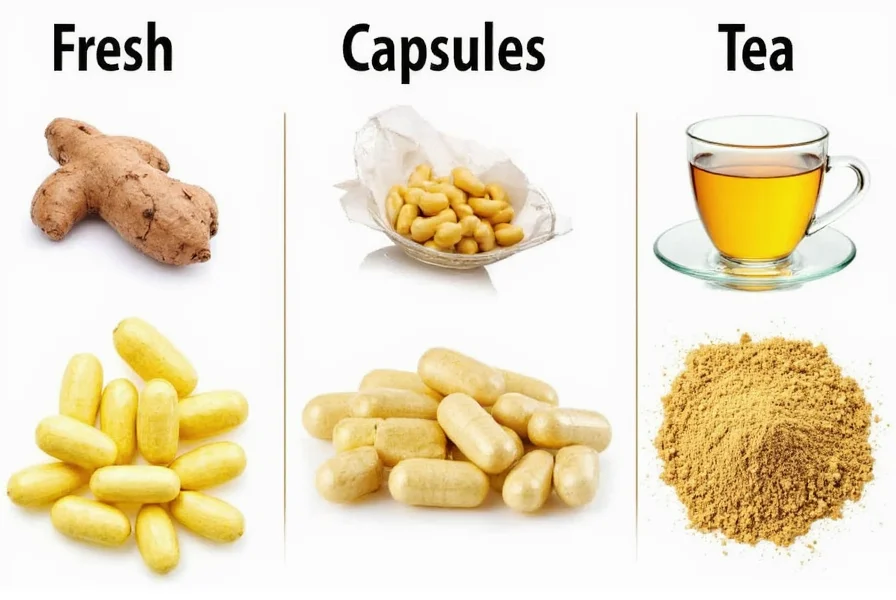For centuries, ginger (Zingiber officinale) has been valued in traditional medicine systems worldwide. Modern science continues to validate many of these traditional uses while exploring new potential applications. This comprehensive review examines what current research reveals about ginger's health effects, proper usage, and important considerations for safe consumption.
The Science Behind Ginger's Health Properties
Ginger's therapeutic properties primarily come from its bioactive compounds, particularly gingerols and shogaols. These compounds give ginger its distinctive flavor and provide powerful anti-inflammatory and antioxidant effects. When consumed, these compounds interact with multiple biological pathways in the body, explaining ginger's wide-ranging potential health benefits.
Unlike many herbal remedies that lack scientific validation, ginger has been the subject of numerous clinical trials and systematic reviews. Research published in the Journal of Ethnopharmacology confirms that ginger's mechanisms of action are well-documented, particularly for digestive health and inflammation modulation.
Evidence-Based Health Benefits of Ginger
Nausea and Digestive Relief
Ginger's most well-established benefit is for nausea relief. Multiple studies demonstrate ginger's effectiveness for:
- Morning sickness during pregnancy (with proper medical guidance)
- Post-operative nausea
- Chemotherapy-induced nausea
- Motion sickness
A comprehensive review in Obstetrics & Gynecology found that 1 gram of ginger daily significantly reduced pregnancy-related nausea without adverse effects. For digestive issues, ginger accelerates gastric emptying and reduces intestinal cramping, making it valuable for those with functional dyspepsia.
Inflammation and Pain Management
Ginger's anti-inflammatory properties show promise for managing various pain conditions. Research in Arthritis & Rheumatism demonstrated that ginger extract reduced osteoarthritis knee pain by 30% compared to placebo. The mechanism appears similar to non-steroidal anti-inflammatory drugs (NSAIDs) but with fewer gastrointestinal side effects.
Athletes may benefit from ginger's ability to reduce muscle soreness. A study in the Journal of Pain found that daily ginger consumption decreased exercise-induced muscle pain by 25%. This makes ginger a valuable natural option for active individuals seeking recovery support.
| Health Benefit | Research Status | Recommended Dosage | Time to Notice Effects |
|---|---|---|---|
| Nausea relief | Strong evidence | 1-1.5g daily | Within 30-60 minutes |
| Muscle pain reduction | Good evidence | 2g daily | After 6-11 days of consistent use |
| Blood sugar control | Promising but limited evidence | 1.6-3g daily | Several weeks |
| Heart health markers | Emerging evidence | 2-3g daily | Months of consistent use |
Metabolic Health Support
Emerging research suggests ginger may benefit metabolic health. A clinical trial published in Nutrition Research found that 2 grams of ginger powder daily significantly lowered fasting blood sugar and improved insulin sensitivity in people with type 2 diabetes. Ginger may also positively affect cholesterol levels, with studies showing reductions in LDL cholesterol and triglycerides.
Other Potential Benefits
While research continues, preliminary studies suggest ginger might support:
- Immune function: Ginger's antioxidant properties may strengthen immune response
- Menstrual pain: Several studies show reduced severity and duration of menstrual cramps
- Brain health: Animal studies suggest neuroprotective effects, though human research is limited

How to Use Ginger for Maximum Health Benefits
The effectiveness of ginger depends on proper usage. Different forms provide varying concentrations of active compounds:
- Fresh ginger: Contains highest gingerol content; best for immediate use
- Dried ginger powder: More concentrated shogaols; better for long-term storage
- Ginger extracts: Standardized for specific compound concentrations
- Ginger tea: Effective for digestive issues and nausea
For nausea relief, consuming 1-1.5 grams of ginger (about 1 tablespoon grated fresh ginger) 30 minutes before potential nausea triggers works best. For chronic inflammation, consistent daily intake of 2 grams provides optimal results. Cooking ginger slightly reduces potency but maintains significant benefits.
Safety Considerations and Potential Side Effects
Ginger is generally safe for most people when consumed in food amounts or moderate supplemental doses. However, some individuals should exercise caution:
- Those taking blood thinners (ginger may increase bleeding risk)
- People with gallstone disease (ginger stimulates bile production)
- Individuals with low blood pressure (ginger may lower it further)
- Pregnant women beyond first trimester (consult physician before regular use)
Common side effects at higher doses (over 4 grams daily) include heartburn, diarrhea, and mouth irritation. Most research shows ginger is well-tolerated at standard doses of 1-2 grams daily. Always consult your healthcare provider before using ginger therapeutically if you have medical conditions or take medications.

Understanding Research Limitations
While ginger shows significant promise, it's important to recognize research limitations. Many studies use small sample sizes or animal models rather than human trials. The optimal dosage, long-term effects, and comparative effectiveness against conventional treatments require more investigation. Ginger should complement—not replace—standard medical care for serious conditions.
Current evidence supports ginger as a valuable dietary component with specific therapeutic applications, particularly for nausea and inflammation. As research continues, we may discover additional applications for this versatile root.
Frequently Asked Questions
How much ginger should I take for nausea relief?
For nausea relief, research shows that 1-1.5 grams of ginger daily is effective. This equals about 1 tablespoon of freshly grated ginger or one standard ginger supplement capsule. Consume 30-60 minutes before situations that typically trigger nausea.
Can ginger interact with blood pressure medications?
Yes, ginger may interact with blood pressure medications as it can lower blood pressure. If you take antihypertensive drugs, consult your physician before using ginger therapeutically. Monitoring your blood pressure when starting ginger supplementation is advisable.
Is fresh ginger more effective than powdered ginger?
Fresh and powdered ginger have different compound profiles. Fresh ginger contains more gingerols, while dried powder has higher shogaol content due to the drying process. Both forms are effective, but for specific conditions like nausea, fresh ginger may provide faster relief, while powdered ginger offers more concentrated anti-inflammatory effects.
Can pregnant women safely use ginger for morning sickness?
Yes, multiple studies show ginger is safe and effective for pregnancy-related nausea when used appropriately. The recommended dose is 1 gram daily, typically divided into multiple smaller doses. However, pregnant women should always consult their healthcare provider before starting ginger supplementation, especially beyond the first trimester.











 浙公网安备
33010002000092号
浙公网安备
33010002000092号 浙B2-20120091-4
浙B2-20120091-4